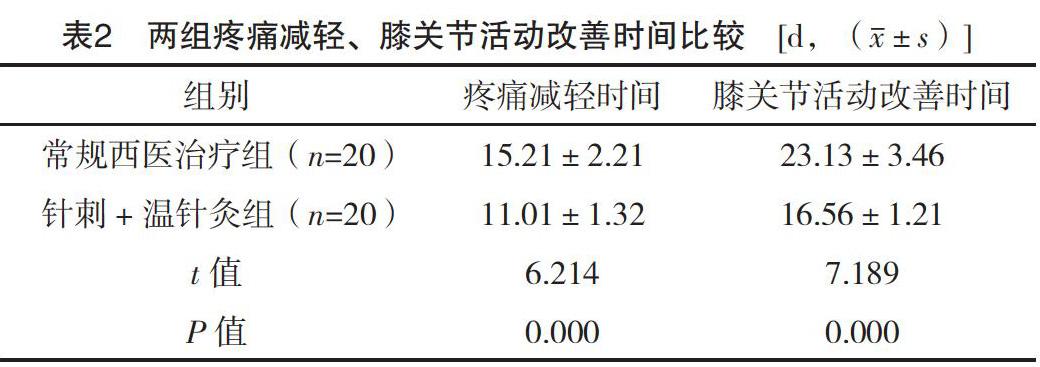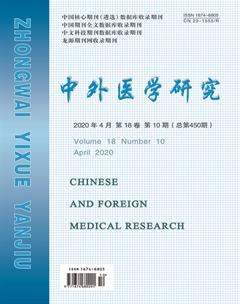针刺结合足三里温针灸治疗膝骨关节炎的临床效果及预后分析
关韶勇 张立波 王建涛


【摘要】 目的:探討针刺结合足三里温针灸治疗膝骨关节炎的临床效果及预后。方法:将笔者所在医院2016年6月-2018年10月的40例膝骨关节炎患者,随机分为两组,每组20例。常规西医治疗组对膝骨关节炎患者予以常规西医治疗,针刺+温针灸组对膝骨关节炎患者以西医+针刺结合足三里温针灸。比较两组疗效、疼痛减轻及膝关节活动改善时间、治疗前后视觉模拟疼痛程度评分、TNF-α、IL-6及hs-CRP、并发症发生率。结果:针刺+温针灸组的总有效率为100%,高于常规西医治疗组的80%,差异有统计学意义(P<0.05)。治疗前两组视觉模拟疼痛程度评分、TNF-α、IL-6、hs-CRP比较差异均无统计学意义(P>0.05);治疗后针刺+温针灸组视觉模拟疼痛程度评分、TNF-α、IL-6、hs-CRP优于常规西医治疗组,差异有统计学意义(P<0.05)。针刺+温针灸组疼痛减轻、膝关节活动改善时间优于常规西医治疗组,差异有统计学意义(P<0.05),且其并发症发生率低于常规西医治疗组,差异有统计学意义(P<0.05)。结论:膝骨关节炎患者实施西医+针刺结合足三里温针灸可获得较好的效果,可更好地缓解疼痛,控制炎症,减少并发症。
【关键词】 针刺 足三里温针灸治疗 膝骨关节炎 临床效果 疼痛 炎症
doi:10.14033/j.cnki.cfmr.2020.10.007 文献标识码 B 文章编号 1674-6805(2020)10-00-03
Clinical Effect and Prognosis of Acupuncture Combined with Zusanli Warm Acupuncture and Moxibustion in the Treatment of Knee Osteoarthritis/GUAN Shaoyong, ZHANG Libo, WANG Jiantao. //Chinese and Foreign Medical Research, 2020, 18(10): -18
[Abstract] Objective: To explore the clinical effect and prognosis of acupuncture combined with Zusanli warm acupuncture and moxibustion in the treatment of knee osteoarthritis. Method: A total of 40 patients with knee osteoarthritis in our hospital from June 2016 to October 2018 were randomly divided into two groups, 20 cases in each group. Routine western medicine treatment group treated knee osteoarthritis patients with routine western medicine treatment, acupuncture+warming moxibustion group treated with western medicine+acupuncture combined with Zusanli warm acupuncture and moxibustion. The curative effect, pain relief and knee joint activity improvement time, visual analogue pain score, TNF-alpha, IL-6 and hs-CRP before and after treatment, and the incidence of complications were compared between the two groups. Result: The total curative effect of acupuncture+warming moxibustion group was 100%, which was higher than 80% of the conventional western medicine treatment group, the difference was statistically significant (P<0.05). Before treatment, the scores of visual analogue pain, TNF-a, IL-6 and hs-CRP in the two groups were not statistically significant (P>0.05). After treatment, the scores of visual analogue pain, TNF-a, IL-6 and hs-CRP in the acupuncture+warming moxibustion group were better than those in the conventional western medicine treatment group, the differences were statistically significant (P<0.05). Acupuncture+warming moxibustion group had better pain relief and knee joint activity improvement time than that of conventional western medicine treatment group, the differences were statistically significant (P<0.05), and the incidence of complications was lower than that of the conventional western medicine treatment group (P<0.05). Conclusion: Western medicine plus acupuncture combined with Zusanli warm acupuncture and moxibustion can achieve better results in relieving pain, controlling inflammation and reducing complications in patients with knee osteoarthritis.

